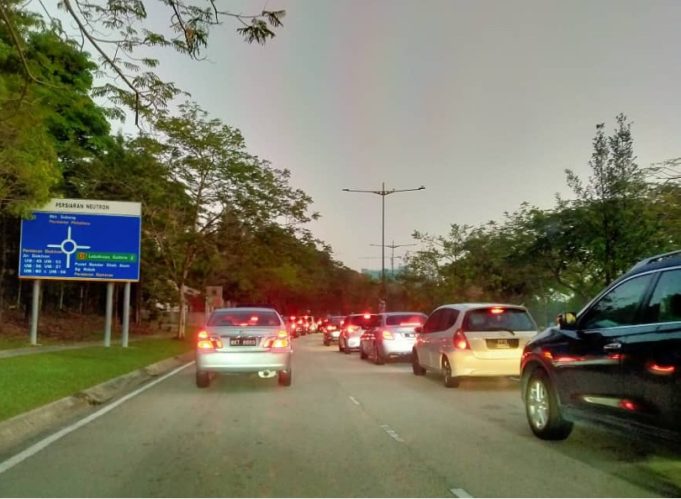From Ashraf Abdullah
Sime Darby Property’s “City of Elmina” was marketed as a visionary development – 5,000 acres of master-planned community living in Shah Alam, nestled next to a forest reserve, and filled with parks, lifestyle hubs, and social spaces.
Launched in 2001 with the Bukit Subang township, the project has spanned over two decades and is set to continue for a total of 41 years. Today, it comprises several townships: Elmina East, Elmina West, Denai Alam, and Bukit Subang. It is home to 40,000 residents, mostly those in the upper-middle to high-income brackets.
But for many of those residents, daily life in this “cohesive environment” begins and ends in gridlock.
What should be a one-kilometre drive from home to the nearest exit can take up to an hour during peak hours. Despite its proximity to major highways, including the Guthrie Corridor Expressway and the DASH Highway, the City of Elmina has become a tragic case study in how systemic failure across multiple layers of responsibility can destroy the promise of homeownership. A dream for thousands has turned into a daily nightmare.
The traffic gridlock gripping Elmina, Denai Alam, and Bukit Subang is not just the result of one developer’s oversight. It is the product of a broken system – where Sime Darby Property and other developers push out high-density developments, and approving authorities like Shah Alam City Council (MBSA), the Malaysian Highway Authority (LLM), and the Public Works Department (JKR) rubber-stamp projects without enforcing meaningful planning safeguards.
Each party has done just enough to meet technical checklists. Government and legal requirements are met at the bare minimum. No one has stepped up to protect long-term livability. And now, the residents are paying the price.
At the core of this failure lies the Traffic Impact Assessment (TIA), a report that every major development in Malaysia must submit. Developers appoint a certified Traffic Engineering Consultant (TEC) – a Professional Engineer with a Practising Certificate (PEPC) – to forecast traffic outcomes and propose solutions.
But in this case, the system has been reduced to a formality. Developers pay the consultants, the consultants deliver reports that merely tick the boxes, and authorities wave the approvals through.
In the case of Elmina and surrounding townships, the TIAs clearly missed the mark. They failed to predict or plan for the scale of congestion that now suffocates the area. Either the projections were wrong, or worse, were never meant to be taken seriously in the first place.
The traffic mess is not just from within Elmina. Every weekday, residents from neighbouring townships – including Puncak Perdana, Subang Bestari, Saujana Utama, and Sungai Buloh – cut through Elmina’s internal roads to reach the Guthrie Corridor Expressway or head into Kuala Lumpur. These roads were never designed to serve as regional bypasses, but they have become one out of necessity.
As traffic spills in from outside communities, Elmina’s internal road system collapses under pressure. The fact that this was not anticipated by approving authorities or mitigated in the TIA process shows a staggering lack of foresight – and a lack of will from all parties involved to fix it.
Parks and green spaces look great in brochures, but they do not move traffic. Liveability is not about how many trees are planted – it is about whether you can get to work on time, or pick up your kids from school without sitting in a jam for an hour.
Down goes the value of properties
As congestion worsens, the value of homes in Bukit Subang, Denai Alam, and Elmina has likely already taken a hit. What good is a high-end home if you cannot leave your street in the morning?
Potential buyers are beginning to take note. In time, properties will be harder to sell. Interest in new launches will begin to cool. If Sime Darby and others do not course-correct soon, they risk having a product that people do not want – regardless of how beautiful or well-branded it is.
Missing in action – the authorities
Shah Alam City Council (MBSA), the Malaysian Highway Authority (LLM), and the Public Works Department (JKR) all bear responsibility for this disaster. MBSA continues to approve new developments despite knowing full well that the existing road network cannot cope. LLM and JKR have not taken any meaningful steps to create alternate exits or secure direct access to DASH. Several meetings have been held with residents’ associations etc, but action is moving at a snail’s pace. Bureaucracy of the highest order.
Instead of planning together, authorities operate in silos. Developers are left to “self-regulate,” and no one checks whether infrastructure is keeping up with housing approvals. The result is obvious on the roads every day.
Time to Hit Pause: A Call to the Selangor State Government
The political leadership in Selangor must step in immediately. This situation is no longer manageable through minor fixes or polite petitions. A complete moratorium on all new development phases in Elmina, Denai Alam, and Bukit Subang must be enforced until:
- A full and independent review of all existing TIAs is conducted
- A detailed infrastructure recovery and upgrade plan is in place
- Direct access to highways like DASH is secured
- New traffic routes and bypasses are funded and executed
- Developers contribute substantially to these infrastructure costs
If state leaders continue to ignore this issue, they risk being remembered not for their development policies – but for standing idle as families suffered through a self-inflicted urban planning crisis.
Politicians Will Pay the Price at the Ballot Box
Residents are angry, and rightfully so. Their daily lives are disrupted, their property values are falling, and their quality of life has taken a massive hit. And they will not forget who allowed this to happen.
Politicians – local council representatives, State Assemblymen, and Members of Parliament – need to understand one thing: traffic is a political issue. It affects everyone, every day. Come the next general election, voters in these areas will show their dissatisfaction at the ballot box. Promises won’t be enough. The people want results – and accountability.
Final Word: Stop Building, Start Fixing
The traffic crisis in the City of Elmina is not just a planning mistake. It is a reflection of a deeply broken system – where approvals are handed out without accountability, where developers prioritise sales over sustainability, and where authorities refuse to act until it is too late.
This is not just Sime Darby’s fault. It is a systemic failure that spans consultants, councils, highway agencies, and state leaders. And if it is not corrected now, the damage will only get worse.
Stop the new launches. Halt the approvals. Fix the roads. Rebuild the trust.
No one wants to buy into a township that looks great on paper but fails at the first turn out of the driveway.
(Ashraf Abdullah is a former Group Managing Editor of Media Prima Berhad’s Television Networks and a resident of Denai Alam).
—The views expressed are those of the writer and do not necessarily reflect those of MalaysiaGazette.


















I’m totally agreed of the above . The people are suffering and victims of the ineffectiveness of local authorities in giving such approval without proper homework’s
Where we should address this ?
Well said.
Good article. Spot on. Generally it happen all across Malaysia. Development causing traffic gridlock. No land provided for extra lane reserve. One lane road stay as one lane road until another 100 years perhaps? Development taken place until right in front of road. Fully utilised their land space. Even long time ago gas piping area is not spared. The authorities just blindly approve any new housing project as developer rub them with “affordable housing” term. Example 20% of the project is allocated for house below RM200k price. Whether apartment or townhouse or even single storey terrace. To add more sweet, “special discount” term was used, priority to army, police, or overall government servant. Of course local council straight approve. Politician then use this as their political mileage. An “affordable housing” provided to the rakyat. Special discount for their fixed deposit which is government servant. Traffic congestion or no public amenities like school or hospital? I don’t care cause my brain only can think kemudahan to rakyat is affordable housing. Kan harga rumah makin lama makin mahal. Other things? That ‘s my successor problem.
its the same everywhere else, the developers take charge of everything and the authority supports almost anything, both with same objective, money..
Just complaints made to authorities will bear no results. get together and take the authorities to task and demand compensation after getting independent consultants to assess.
Alam sari is the same
not just elmina and it is a great example to start with. you really can just look at kl and old klang road puchong subang. all roads from pj and puchong merge into the arterial old kland road, and to get out of the taman can take an hour, because of conjestion at the traffic lights. its horrendous.
yet they have the ?? to introduce bus lanes, and cars already stuck 4 lanes deep have to risk using these bus lanes.
i cant believe the level of greed and incompetence.
I agree with Ashraf’s article. The exit from Elmina into the GCE is badly designed. This has compounded the traffic problem at the Denai Alam exit into the GCE especially in the morning. It looks like a traffic policeman is needed to man the junction at both exits in the morning. The DASH highway is also contributing to the traffic problem especially in the evening. Just look the the junction at Johawaki in the evening. What a nightmare. The traffic study needs to be redone in view of the changes to the situation in the area.
Terbaik. Developers only worry about profits
The dire situation is not only happening in Elmina. The same is happening in another township in Teluk Panglima Garang. The 4 main developers, Gamuda Land (TwentyFive.7), IJM (Rimbayu), Ecoworld (Eco Sanctuary), and Tropicana (Tropicana Aman) aim to develop a township next to Kota Kemuning that will rival Desa Park City. The township is only starting but traffic congestion is already very bad without any solution in sight. Those who are staying in this township goes through already congested roads of Kota Kemuning to access Kesas and Lekas highways, and of Bandar Saujana Putra to Elite. The developers are pointing fingers at each other and the authorities are nowhere to be seen. Meanwhile, the developers continue to launch parcels after parcels of properties, which will worsen the current traffic congestion in the very near future. It’s really a very sad sad situation.
This NIMBY idiot writer thinks the fix to congestion is more roads and more assessments for roads. Surprisingly, zero thought put behind a “think piece”.
Waiting for the consultants to respond. Anyway, same thing is happening to my residential area, Ambangan Heights in SP. Our road now a bypass route for cars from south SP area to get to north, avoiding main road infront of Amanjaya Mall.
Now our area started having 2000 more houses being build, i cannot fanthom what will happened to readily congested roads once al of the 4 new projects starts having residents.
“The whole of Malaysia is experiencing the same problem — traffic congestion everywhere.”
Setuju. Ini adalah salah satu contoh yang membuktikan bahawa tidak semua yang moden itu maju dan bagus. Lambakan perumahan di kawasan yang pesat, merencatkan pergerakan trafik. Tiada jalan penyelesaian yang singkat, melainkan kesabaran dan perubahan waktu keluar bekerja.
Dunia semakin tenat tetapi manusia menjanjikan dan dijanjikan kehidupan yang serba lengkap dan ketenangan oleh pemaju perumahan yang rakus dan tamak. Ketahuilah, kematian itu pasti dan semakin hampir. Akhirat itu pasti. Kesusahan di dunia hanyalah bersifat sementara, harungilah dengan cekal dan pupuklah sifat bersangka baik pada Tuhan. Korbankan kesenangan di dunia untuk akhirat yang abadi, kekal selama-lamanya.
Akhir kata, kemodenan bukanlah sesuatu yang perlu diusaha dan dibangga-banggakan kerana ianya memberi impak yang negatif kepada kemajuan akhlak dan adab insan.
WHat you expect when greed of the MB and the council fat pigs eat all day no work no think. having their dicks in their hands all day.
You think only Elmina. Looks at Eco Majestic, etc. Semenyih……
Alam Impian in Shah Alam is the same. It become a shortcut and lesser toll fee compared to KESAS for Klang and Port Klang residents.